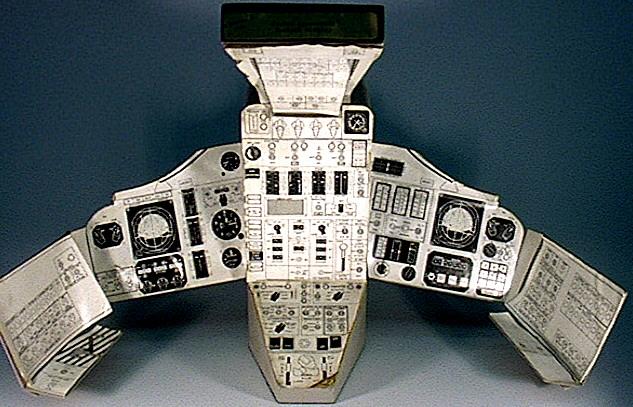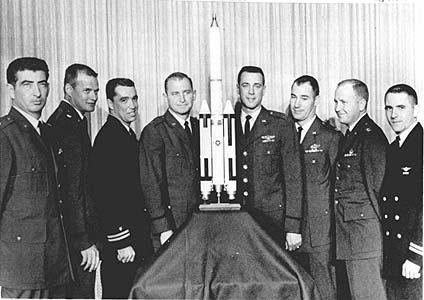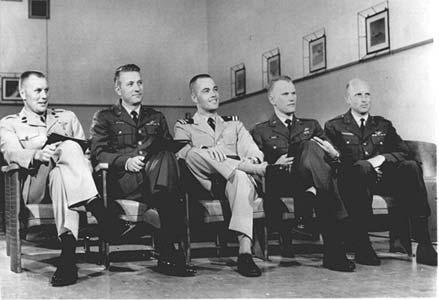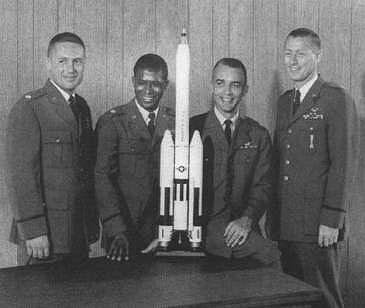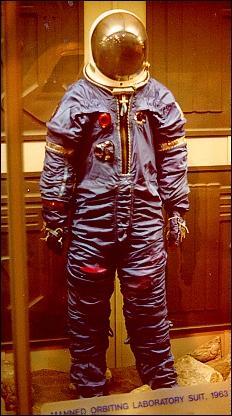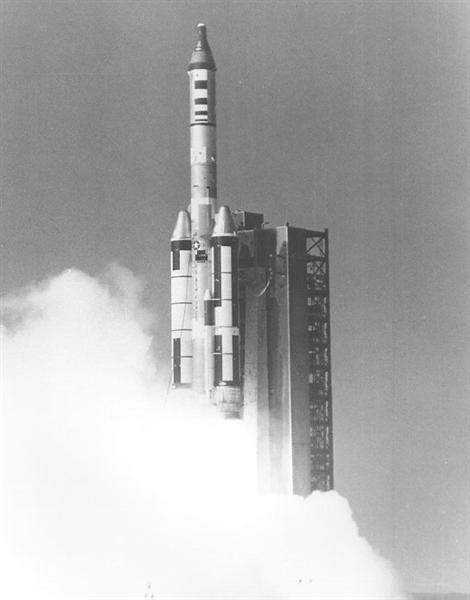|
|
||||||||||
|
... Watchtower: the Manned Orbiting
Laboratory (MOL)
In the early days of the American space program, there were 2 manned programs: one civilian, under NASA, and one military. At the time, there were no treaties or agreements stating that space was off-limits to military operations; indeed, the whole space effort was deemed a military challenge, an extension of the Cold War and the arms race between the United States and the Soviet Union. It was assumed that the Soviets were planning to have manned military space stations within a few years (a correct assumption), and that the United States military had to respond in kind. Both the Pentagon and the Kremlin assumed that combat operations in space would be inevitible in the event of future confrontations. The first avenue open to development was reconnaissance. Just as aircraft had been mainly used for scouting and observation in the early days, spacecraft would begin their military careers spying on the enemy. Space afforded the ultimate vantage point; while the vulnerability of spyplanes like the U-2 was well known (and proven with the downing of Francis Gary Powers' U-2 over Russia and another over Cuba during the Cuban Missile Crisis), orbital spy platforms flew higher and faster than any known weapon could reach. Both sides were developing spy satellites-the best-known today being the American CORONA series. But at the time, these systems were very limited in capability.
Thus was born the Manned Orbiting Laboratory, or MOL. MOL emerged in the early 1960s when NASA began developing an adavanced, 2-seat Mercury capsule-the spacraft that became Gemini. Gemini was to be an altogether more capable vehicle than the essentially ballistic Mercury capsule; it could maneuver with precision, change orbits, and it would be equipped to develop and demonstrate orbital rendezvous and docking techniques for the upcoming Apollo lunar missions. And it was a 2-seater, which made it more flexible. This made Gemini a perfect vehicle to deliver a 2-man crew to a semi-permanent orbital recon platform. The MOL was made up of 5 sections, 3 of which would be pressurized. The Main Cabin contained the reconnaissance systems; the Auxiliary Cabin was the living quarters; and the Experiment Module contained research equipment pertinent to the MOL's military missions. These included tests of large optics systems in space, orbital target tracking, electromagnetic intelligence, multi-spectral photography, and post-strike damage assessment. MOL's primary instrument was a 6-ft-dia. KH-10 spy camera, codename DORIAN, which could spot objects as small as a softball from orbit. The Equipment & Transtage Modules contained life-support and propulsion systems, respectively. MOL was not a permanent space station; it was designed to be launched with the Gemini on top on a big Titan III booster to a polar orbit at 150 mi altitude, operate manned for 30 days (drawback: no shower), and after departure of the crew in the Gemini, it would burn up.
The MOL Gemini variant was known as Gemini-B, and it differed significantly from the NASA bird. Although the structure and guidance and control systems would be basically the same, Gemini-B had a hatch in the aft section, permitting the crew to enter the MOL. At first, this redesign caused engineers at McDonnell Aircraft concern, because the hatch would create an opening in the heat shield; they didn't know how well it would withstand re-entry. It would also pass through the Adaptor Section. Internal systems were containerized and designed for long term orbital storage. The cockpit layout was completely redesigned and new instruments were developed. The cant of the ejection seats were changed in order to make room for the hatch in the heat shield between the crew's shoulders. After the Apollo 1 fire, cabin atmosphere was changed to helium-oxygen in place of pure oxygen. At launch, the crew breathed pure O2 in their suits while the cabin was filled with helium. During ascent, cabin atmosphere was slowly brought up to the helium-oxygen content of the station. (SEALAB and other deep-diving systems also used a helium system similar to this. Drawback: the crews' voices sounded like Alvin and the Chipmunks.) In order to handle higher energy re-entries from polar orbit, the heat shield was increased in diameter, so that it actually stuck out a bit from the base of the re-entry vehicle. The OAMS thrusters of the NASA Gemini were deleted; spacecraft orientation was handled by the forward RCS thrusters. The number of solid-fuel retrorockets was increased from 4 to 6. These served double-duty: for deorbit, and as abort rockets for separation from the booster in case of launch vehicle failure. Gemini-B would have been flown alone, without an active MOL, unmanned, in 2 test launches of the Titan IIIM prior to the first manned MOL flight. Gemini-B was not designed to fly separately. After reaching orbit, the crew would shut down the capsule's systems, leave their seats-no mean feat in the cramped Gemini cockpit, which was about the size of the interior of a Corvette-and float through the hatch into a tunnel that accessed the MOL. After 30 days, the crew would return to the Gemini-B, separate from the MOL, and go home. Gemini-B had only 14 hours of 'loiter capability' after separation from the MOL.
L-R: Michael J. Adams, USAF; Albert H. Crews, USAF; John L. Finley, USN; Richard E. Lawyer, USAF; Lachlan Macleay, USAF; Francis G. Neubeck, USAF; James M. Taylor, USAF; and Richard H. Truly, USN. Unlike the NASA, which allowed civilian astronauts like Elliot See, Neil Armstrong, and a number of scientist-astronauts into their ranks, all of the MOL astronauts were active-duty military. There were no "scientist-astronauts" in the MOL program-they were all pilots, and referred to themselves as such rather than "astronauts." When the first round of MOL pilots was chosen in 1965, they were hand-picked from the ranks of ARPS students, instructors, & graduates by schoolmaster Chuck Yeager and his deputy. Some MOL pilots, such as ex-U-2 pilot Lachlan Macleay, had applied for the NASA astronaut program; Macleay had applied twice, but at 6' 2", was turned down for being too tall.
L-R: Robert F. (Bob) Overmyer, USMC; Henry W. (Hank) Hartsfield, USAF; Robert L. Crippen, USN; Karol J. Bobko, USAF; and Charles Gordon Fullerton, USAF. Every member of this group would go on to fly the Shuttle.
L-R: Robert T. Herres, USAF; Robert H. Lawrence, Jr., USAF; Dr. Donald H. Peterson, USAF; and James A. Abrahamson, USAF.
Maj. Robert H. Lawrence, Jr., the first African-American to be chosen as an astronaut by either NASA or the military. He was born Oct. 2, 1935, in Chicago. He graduated from high school at 16 and Bradley University at 20 with a Bachelor's in Chemistry. He was Cadet Commander of Bradley AFROTC and was commissioned 2nd Lieutenant in the Air Force Reserve. He entered flight training, and after graduation became a T-33 instructor, training USAF & Luftwaffe pilots. He earned a Doctorate in Physical Chemistry from Ohio State. He graduated from the USAF Test Pilot School at Edwards in June 1967, and was selected for the MOL program. Sadly, he never got to fly in space. On Dec. 8, 1967, Maj. Lawrence was in the back seat of an F-104D piloted by ARPS Operations Chief Maj. Harvey Royer, practicing "divebomber approaches" used by the X-15 and Lifting Bodies, when Royer misjudged an approach and hit the runway too hard. The landing gear collapsed, and the fuselage bounced back into the air, trailing fire. It hit the ground again 2,000 feet further down the runway and began to disintegrate as it veered off into the desert. Both pilots ejected. Royer survived, but Maj. Lawrence was killed, when his parachute failed to deploy properly.
While MOL was designed to give crews a shirtsleeve environment, spacesuits would be needed for launch, re-entry & EVA.The military purchased prototype suits from David Clark Co. (DCC) & International Latex Corp. (ILC, now ILC Dover). In 1967, DCC, ILC & Hamilton Standard (now Hamilton Sundstrand) competed for a suit production contract. HS won.The MOL MH-7 Training Suit above is from that contract. Thanks to Ken Thomas for the info.
The only launch of the MOL program took place on Nov. 3, 1966, when a Titan IIIC lifted off from Launch Complex 40, Cape Canaveral AFS, with an unmanned Gemini B & mockup MOL containing 3 small satellites. MOL was to use a "man-rated" Titan IIIM similar to this, but the booster wasn't ready in time for flight tests. MOLs were to launch from Space Launch Complex 6 (SLC-6/"Slick-6") at Vandenberg AFB, CA. Vandenberg could launch to polar orbits which would bring everyplace on Earth under the watchful eye of the KH-10, including Soviet sub bases above the Arctic Circle. The end came in the summer of 1969. Spy satellite technology surpassed MOL's capabilities, and the USAF could no longer afford it. The program was cancelled on June 10, 1969. Thousands of jobs were cut. But MOL pilots Overmyer, Bobko, Peterson, Fullerton, Hartsfield, Crippen, & Truly went to NASA, and went on to fly Shuttle missions. MOL & Titan IIIM never flew, although its improvements were incorporated into the Titan III family. SLC-6 was closed, rebuilt for the Shuttle, closed again, and only recently began launching satellites. SOURCE: SPACE COWBOY'S SALOON |
||||||||||
| SEE ALSO: | ||||||||||
| FAIR USE NOTICE: This page contains copyrighted material the use of which has not been specifically authorized by the copyright owner. Pegasus Research Consortium distributes this material without profit to those who have expressed a prior interest in receiving the included information for research and educational purposes. We believe this constitutes a fair use of any such copyrighted material as provided for in 17 U.S.C § 107. If you wish to use copyrighted material from this site for purposes of your own that go beyond fair use, you must obtain permission from the copyright owner. | ||||||||||
|
|


